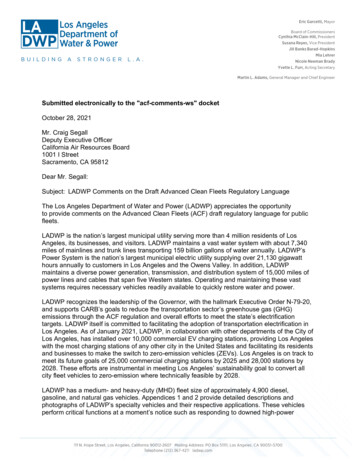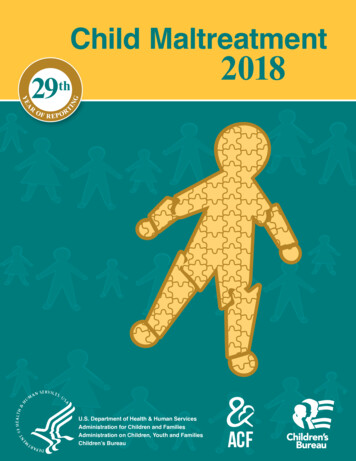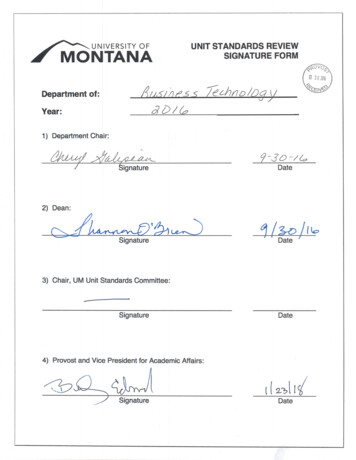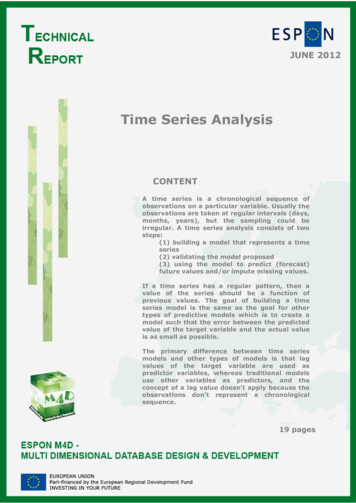
Transcription
Submitted electronically to the "acf-comments-ws" docketOctober 28, 2021Mr. Craig SegallDeputy Executive OfficerCalifornia Air Resources Board1001 I StreetSacramento, CA 95812Dear Mr. Segall:Subject: LADWP Comments on the Draft Advanced Clean Fleets Regulatory LanguageThe Los Angeles Department of Water and Power (LADWP) appreciates the opportunityto provide comments on the Advanced Clean Fleets (ACF) draft regulatory language for publicfleets.LADWP is the nation’s largest municipal utility serving more than 4 million residents of LosAngeles, its businesses, and visitors. LADWP maintains a vast water system with about 7,340miles of mainlines and trunk lines transporting 159 billion gallons of water annually. LADWP’sPower System is the nation’s largest municipal electric utility supplying over 21,130 gigawatthours annually to customers in Los Angeles and the Owens Valley. In addition, LADWPmaintains a diverse power generation, transmission, and distribution system of 15,000 miles ofpower lines and cables that span five Western states. Operating and maintaining these vastsystems requires necessary vehicles readily available to quickly restore water and power.LADWP recognizes the leadership of the Governor, with the hallmark Executive Order N-79-20,and supports CARB’s goals to reduce the transportation sector’s greenhouse gas (GHG)emissions through the ACF regulation and overall efforts to meet the state’s electrificationtargets. LADWP itself is committed to facilitating the adoption of transportation electrification inLos Angeles. As of January 2021, LADWP, in collaboration with other departments of the City ofLos Angeles, has installed over 10,000 commercial EV charging stations, providing Los Angeleswith the most charging stations of any other city in the United States and facilitating its residentsand businesses to make the switch to zero-emission vehicles (ZEVs). Los Angeles is on track tomeet its future goals of 25,000 commercial charging stations by 2025 and 28,000 stations by2028. These efforts are instrumental in meeting Los Angeles’ sustainability goal to convert allcity fleet vehicles to zero-emission where technically feasible by 2028.LADWP has a medium- and heavy-duty (MHD) fleet size of approximately 4,900 diesel,gasoline, and natural gas vehicles. Appendices 1 and 2 provide detailed descriptions andphotographs of LADWP’s specialty vehicles and their respective applications. These vehiclesperform critical functions at a moment’s notice such as responding to downed high-power
Mr. SegallPage 2October 28, 2021voltage lines or damaged trunk lines flowing thousands of gallons of water. LADWP needs thesespecialty vehicles to quickly address these situations, which are not only service disruptions butare often threats to public health and safety.LADWP has been actively looking to expand its fleet to include ZEVs and near-zero-emissionvehicles (NZEVs) by engaging with manufacturers and pilot testing MHD ZEVs. In the last twoyears, LADWP has tested a Trans Power Class 8 tractor and a Lightning Box Van. LADWP wasrecently involved in testing and collecting data on a ROUSH CleanTech all-electric Ford F-650stake bed demo unit. LADWP has yet to test prototypes that meet the rigorous demands ofLADWP’s water and power operations. In the meantime, LADWP continues to provideproprietary feedback and data to the manufacturers in the hopes of contributing to the continueddevelopment of these vehicles. LADWP has also committed to purchasing 100 Ford F-150Lightning electric pickup trucks as soon as they become available. Additionally, LADWP iswilling to partner with CARB on future pilot tests and other efforts promoting the use of ZEVsand NZEVs.While LADWP supports CARB’s electrification goals and is committed to electrification effortswherever feasible, LADWP requests CARB to take into account the following considerationsand recommendations for the proposed draft ACF regulation:1. LADWP is a Provider of Essential Public Service (PEPS) and operates a large MHD fleetof specialty utility vehicles needed to maintain reliable water and power throughoutLADWP’s extensive service territory.a. The unavailability of ZEV specialty vehicles could impact LADWP’s role as aPEPS.b. A restrictive and infeasible exemption process can deter LADWP’s ability torestore essential services during emergencies.2. LADWP recommends the following:a. Develop an independent technology review panel to make yearlycommercialization determinations.b. Defer the purchase requirements for Class 7-8 vehicles until the technologyreview panel determines that suitable ZEVs are commercially available.c. Adjust the 75% ZEV threshold requirement for an exemption based on thetechnology review panel’s determinations.d. Clearly define the exemption criteria and process to ensure the reliability ofemergency response vehicles.e. Include early action credits in the draft regulation language to incentivize thedevelopment and adoption of ZEVs.Considerations for Providers of Essential Public ServicesAs part of LADWP’s efforts to transition to ZEVs, providing safe and reliable water and powerservices to its customers remains LADWP’s highest priority. As a PEPS defined under Title 13,California Code of Regulations, Section 2452, LADWP’s primary purpose is to operate andmaintain its facilities and equipment to ensure the continued supply and delivery of essentialwater and power services to the communities it serves. LADWP requests that CARB considerthe critical and unique role as a PEPS, especially electric utilities that need specialty vehicles tocarry out operations and maintain infrastructure that is crucial in supporting electric ZEVs.
Mr. SegallPage 3October 28, 2021Though California law doesn’t specifically categorize utility vehicles as “emergency vehicles”,they do serve to protect the public from threats of health and safety. For this reason, LADWPrequests that CARB consider specialty vehicles in these critical roles. Public utility vehicles thatwork to restore utility services during an outage or emergency scenario should include “[a]nyvehicle . . . equipped and used either for fighting fires, or towing or servicing other vehicles,caring for injured persons, or repairing damaged lighting or electrical equipment.” Cal. Veh.Code, § 165. Furthermore, the human right to water should be considered when “revising,adopting, or establishing policies, regulations, and grant criteria” that impact water used fordomestic purposes. Cal. Health & Saf. Code, § 42352; Cal. Wat. Code, § 106.3 (AB 685(2012)).LADWP encourages CARB to consider the impact the ACF regulation would have on the abilityof utilities to fulfill their critical role of protecting against threats to public health and safety. Aregulation that requires the purchase of ZEVs when they are not yet available or recommendsthat public fleet owners/operators wait to replace older vehicles could significantly impact PEPS’roles.Vehicle AvailabilityLADWP encourages CARB to recognize the importance of vehicle availability and the impact ofthe unavailability of ZEVs on public fleet operations. LADWP fully supports ZEV technologies,but recognizes that ZEVs are not yet suitable for LADWP’s PEPS operations. LADWP hopesthat the MHD ZEV technology will improve as quickly as CARB anticipates, and requests anability to purchase a new vehicle if a ZEV or NZEV is not commercially available.Additionally, due to the COVID-19 pandemic, the resulting global microchip shortage is affectinga variety of industries, including automakers. Manufacturers have stated that they are reducingproduction and have started to implement fleet order cutoffs for select vehicle lines, anticipatingmore cutoffs in the future. Manufacturers will likely need a few years to fulfill the backorders,which could delay the development of new ZEV technology. Although the regulation will not takeeffect until 2024, it is uncertain how long the pandemic’s effect on the economy will last.Additionally, when the ACF regulation is passed, ZEV manufacturers will likely be overwhelmedwith high volumes of purchase orders, which could impact both the production schedule andassociated costs. Requiring ZEV purchases without regard to vehicle availability and supplyconstraints could further delay the much needed replacement of older vehicles.Furthermore, LADWP would like CARB to consider some issues raised regarding ZEV warrantysupport. LADWP was recently informed by a manufacturer that they currently do not havetechnicians who are trained to service new vehicle entrants into the all-electric MHD market.They admitted that they would not be able to provide warranty support in the short term.It is also important to note that public fleets have unique public procurement processes andrestrictions which involve the evaluation of “responsive” bids from “responsible” bidders. Even ifa ZEV is commercially available, a public fleet may not be able to purchase the vehicle if it doesnot receive bids that meet the required technical specifications from at least two responsible andreliable suppliers. It is important to recognize that receiving a bid for a vehicle does notguarantee that the vehicle will be delivered, delivered on time, or be able to perform asadvertised. LADWP encourages CARB to incorporate safeguards in the regulation to ensurevehicle manufacturers are providing reliable vehicles.
Mr. SegallPage 4October 28, 2021Recommendations:Technology Review Panel & ZEV DatabaseLADWP supports the idea of an independent technology review panel consisting of subjectmatter experts authorized to make yearly commercialization determinations. The technologyreview panel would ensure that particular ZEVs are available for purchase, can be deliveredwithin a reasonable amount of time, and have demonstrated that they are capable of meetingthe specifications, duty cycles, and performance requirements of existing conventional-fueledvehicles. LADWP also supports the idea of CARB developing a list or database of commerciallyavailable ZEVs and NZEVs based on the technology review panel’s findings. By informing fleetowners/operators on available options, the technology review panel’s recommendations wouldhelp streamline the procurement process, as well as the exemption process, especially in theinitial years of the regulation.The technology review panel should be made of experts representing public fleets, privatefleets, OEMs, industries, and stakeholders. The technology review panel should make yearlyZEV determinations to provide fleet owners/operators certainty when planning their vehiclepurchases. Purchase requirements can be adjusted if the technology review panel determinesthat certain ZEV classes are not commercially available or that available ZEV alternatives do notmatch the specifications or operability of its conventionally fueled counterparts.Class 7-8 ZEVs Purchase RequirementsLADWP suggests deferring the public fleet purchase requirements for Class 7-8 vehicles untilthe technology review panel determines that viable ZEV alternatives are available in the market.Class 2b-6 vehicles are more capable of transitioning to electric vehicles, but Class 7-8 vehicleswill be much more difficult to electrify. They may require fuel cell or fuel cell hybrid technology,which will likely take more time to develop and deploy among Class 7-8 vehicles. Thetechnology review panel should be able to advise on when public fleets can start complying withthe proposed purchase requirements based on its market analysis.CARB CertificationAdditionally, LADWP supports requiring ZEV manufacturers to obtain CARB certification forpower efficiency, warranty, and durability beginning in 2024. LADWP requests that extensivetesting be required to demonstrate ZEV performance under real-world conditions similar tothose that a utility fleet vehicle is subject to in the field. The technology review panel shoulddevelop minimum qualifications with oversight from CARB. For example, the vehicles shouldhave a proven track record of operating in a commercial fleet environment for a minimum of twoyears, travel a total of at least one million miles (which may be equivalent to 10 vehiclestraveling 100,000 miles each) within that period, and have a 90% service reliability or availabilityrate (approximately 325 out of 365 days each year).Exemptions for Emergency ResponseLADWP requests that CARB keep the aforementioned essential services in mind whendeveloping the public fleet exemptions for emergency response. In the event of an emergency,LADWP must be ready to respond at a moment’s notice and restore essential water and power
Mr. SegallPage 5October 28, 2021services as quickly as possible. This requires dispatching reliable vehicles throughout LADWP’slarge service territory, and ensuring adequate fuel or power for the vehicles to travel over longdistances and operate for extended periods on the job site. LADWP’s service territory has beenand continues to be subjected to a variety of natural disasters including wildfires, earthquakes,heat storms, and wind storms, with the most severe natural disaster predicted to be a majorearthquake, similar or greater than the 6.7 magnitude Northridge Earthquake in 1994.LADWP appreciates the inclusion of an exemption process under Section 95693.2 (a) thatwould allow the purchase of non-ZEVs and/or non-NZEVs. However, the first exemptionrequirement that “more than 75 percent of that body type in the fleet are already ZEVs” will bechallenging or even impossible to meet in the near term. At this time, there are currently noZEVs and NZEVs that meet LADWP’s operational needs, and it is unknown when such vehicleswill be available. With a current MHD fleet size of approximately 4,900 diesel, gasoline, andnatural gas vehicles, LADWP would take a long time before qualifying for an exemption. In themeantime, old vehicles will inevitably need to be replaced.LADWP’s fleet is composed of highly customized vehicles with unique specifications requiredfor LADWP’s field operations. These include repairing electrical and water distribution networkswhere equipment may operate well over 12 hours. Other instances require vehicles to travellong distances throughout LADWP’s large service territory, which stretches from the LosAngeles basin to other parts of California, Nevada, and Utah, sometimes well over 600 miles.These vehicles are typically heavier than conventional light-duty trucks, sometimes weighing upto 115,000 pounds. Currently, only diesel, gasoline, and some natural gas MHD vehicles aresuitable to meet the needs of LADWP.As previously stated, LADWP has pilot-tested different body types of ZEVs from differentmanufacturers but has yet to find a ZEV/NZEV that is capable of operating for extended periodsout in the field. Some of the jobs for which the ZEVs were being tested could not be completedwithout having to recharge the vehicles. The MHD ZEVs currently available in the market do notmatch the performance and specifications of existing MHD vehicles and could hinder LADWP’sability to perform routine services and respond to emergencies.Additionally, CARB’s proposed exemption prerequisite to have 75% of a body type be ZEV isnot operationally feasible. For example, LADWP’s patrol trucks are dispatched to investigatepower outages and issues along LADWP’s transmission and distribution lines. Because theytravel long distances to remote locations, they are not suitable as ZEVs. Requiring 75% of thatbody type to be ZEVs would limit the functions of a majority of LADWP’s patrol trucks. Thiscould easily apply to other types of utility vehicles that are expected to be available in the eventof an emergency, such as the case with LADWP. Since LADWP does not have a specific set ofvehicles designated for emergency-only purposes, all LADWP vehicles are consideredemergency response vehicles and are relied on to respond to emergencies within California andsometimes outside the state. For example, the 1994 Northridge Earthquake was an all-handson-deck situation, and every single vehicle was deployed to assist first responders and restorewater and power.Furthermore, LADWP has numerous formal mutual assistance agreements with other agenciesand associations such as American Public Power Association, California Disaster and CivilDefense, California Utilities Emergency Association, California Water Wastewater AgencyResponse Network, Mult-Agency Water, and Western Region (Electric and Natural Gas).
Mr. SegallPage 6October 28, 2021LADWP has participated in mutual aid requests when feasible. A complete transition to ZEVsmay limit LADWP’s ability to provide mutual aid if charging infrastructure is not available inregions where mutual aid is requested.Recommendations:LADWP recommends that, based on the findings from the technology review panel, theimplementation start date of the requirement for 75% of a body type to be ZEV be adjusted untilviable ZEV alternatives are available. In the meantime, LADWP encourages CARB to considerexemptions based on the limitations of emergency services if the available ZEV alternative doesnot meet the needs of the fleet. LADWP requests that more reasonable accommodations beprovided for public fleet vehicles that provide emergency response services.LADWP suggests that CARB adopt a technical infeasibility exemption concept and allow fleetowners/operators the opportunity to apply for an exemption if a ZEV is unable to meetoperational needs. LADWP recommends that criteria for technical infeasibility be wellestablished before rule adoption and that CARB provide a determination within a maximum of90 days. LADWP is open to working with CARB to further develop the exemption process.LADWP suggests that exemptions be granted if any one of the following conditions applies: Fleet owners/operators are able to demonstrate that no engine and chassis or bodyconfiguration is commercially available to perform a specific application due to any of thefollowing:o Unavailability of vehicles that fit a fleet’s specifications.o 1:1 ZEV replacement is not available, which would require fleets to operate andmaintain additional vehicles for a specific operation.o ZEVs require the wheelbase to be extended, which would impact operations.This is especially critical when navigating through narrow streets with steepelevations in very high fire hazard severity zones, or over rough terrains inremote areas.o ZEVs would exceed the legal allowable weight specified by the Department ofTransportation or the Federal Motor Carrier Safety Administration. Specialtyvehicles are often required to have additional attachments for safety andoperability that traditional vehicles may not require. Charging infrastructure is not commercially available within a reasonable number ofmiles from the locations where vehicles will operate. Fleet owners/operators are unable to receive bids for ZEVs from responsive and reliablebidders. ZEVs could not be delivered on time due to significant manufacturer delays/lead times.To help further reduce emissions, CARB can encourage public fleet operators to fund programsthat would offset the incremental increase in GHG emissions between an electric vehicle and aconventionally fueled vehicle.
Mr. SegallPage 7October 28, 2021Additional CommentsEarly Action CreditsWith LADWP ready to purchase ZEVs that fit LADWP’s operational needs as soon as theybecome commercially available, LADWP is very open to the concept of early action credits.LADWP supports CARB’s proposal to provide credits for ZEVs purchased before 2024 towardsthe 2024 purchase requirement, and requests that CARB specify this in the draft regulationlanguage.LADWP also recommends that CARB extend the early action credits for fleets that exceed theZEV purchase requirement in the subsequent years (e.g. providing credit for ZEV purchasesabove 50% in 2024-2026). Another suggestion is to draw from other regulations or programsthat have early action credit provisions and similarly allow a 1.2 or 1.5x credit for ZEVspurchased beyond the required amount towards future vehicle purchase requirements. Theseincentives would encourage fleet owners/operators to consider purchasing new ZEVs, facilitateZEV adoption, and promote market development, while providing flexibility for other ZEVs thatare not yet commercially available.Reporting DeadlineThe current proposal requires fleet owners/operators to submit an annual report by March 1 ofeach year. LADWP suggests moving the reporting deadline to April 1. LADWP, along with otherreporting entities, are subject to important reporting deadlines that coincide with each other,such as South Coast Air Quality Management District’s (SCAQMD) Air Emissions Reporting(AER), CARB’s Mandatory Greenhouse Gas Reporting Regulation, and In-Use Off-RoadVehicle Regulation report (DOORS). Since most of these reporting deadlines occur in March,shifting the reporting deadline a month later would significantly alleviate resource constraints.ConclusionLADWP supports CARB's transition goals and looks forward to working with CARB to furtherrefine the proposed language in ensuring a successful implementation of the ACF regulation.LADWP appreciates CARB's collaboration with the stakeholders and consideration of feedbackprovided. If you have any questions regarding these comments, please contact Ms. AndreaVillarin of my staff at (213) 367- 0409.Sincerely,KatherineRubinDigitally signed byKatherine RubinDate: 2021.10.2818:48:40 -07'00'Katherine RubinManager of Air and Wastewater Quality and ComplianceEC:c/enc: Mr. Tony Brasil, CARBMr. Craig Duehring, CARBMr. Paul Arneja, CARBMs. Andrea Villarin, LADWP
Mr. SegallPage 8October 28, 2021Appendix 1: Detailed Specialty Vehicle DescriptionsOver the years, LADWP has established a set of parameters for operating its specialty vehicles.These parameters, which vary among body types, include traveling a certain distance and beingable to operate for a set number of hours before refueling, all while carrying specified weights.In addition, the vehicles need to operate near areas where fueling infrastructure is readilyavailable. While LADWP remains hopeful that these parameters may be met with ZEVs, therearen’t any commercially available options today. The following are a handful of examples to helpillustrate why 100% ZEVs may not be a viable option for specialty vehicles, especially duringemergency response situations. Like alternative-fueled specialty vehicles, ZEVs will likelyrequire adequate infrastructure, longer chassis, and increased payloads, which could limit thevehicle’s ability to operate in certain areas and situations. While LADWP continually seeks topurchase ZEVs and reduce emissions when possible, LADWP relies on its fleet of specialtyvehicles to fulfill its obligation as a PEPS to reliably maintain water and power services.Aerial Boom TrucksAerial boom trucks (Class 5, 7, & 8), as shown in Appendix 2 (Photograph 17), are operated byline crews when installing new poles and transformers, performing line construction,telecommunications cable maintenance and repair, and responding to service outages. Treetrimming crews also operate these vehicles to perform necessary routine maintenance aroundelectrical lines. During an emergency response, any of these vehicles can be deployed toquickly replace overhead electric equipment and circuits.A mixture of aerial boom trucks is needed to support different types of operations. Most linecrews operate trucks with a 50 to 60 ft boom to work on 40 to 55 ft poles; however, some linecrews operate larger trucks with 80 to 90 ft booms to work on taller 60 to 90 ft poles. LADWPhas been replacing wood poles with steel poles due to their increased strength and longevity.Steel poles meet the increased strength requirements set by California Public UtilitiesCommission (CPUC) to harden electrical systems in California. In most cases, work on a steelpole requires a bucket truck due to regulations prohibiting working on high voltage whilestanding on a steel grounded structure. With these regulations in place, LADWP must havelarger aerial boom trucks to not only maintain the distribution system, but also to repair thesystem during an emergency or natural disaster.Tree trimming crews typically use trucks that have a 50-70 ft boom. The boom length of thesetrucks is determined by a tree database and the CPUC requirements to keep vegetation awayfrom our high voltage lines, which are on 40 to 90-foot poles.When responding to an emergency and restoring power to customers, crews are typicallyworking a 16-hour shift. Requiring a crew to leave a job when the customer has no power torecharge a ZEV is not acceptable. ZEVs need to be equipped with tall enough booms and allowsufficient time to operate at job sites. Work conducted on taller poles often have power lineswith higher voltages, which typically service larger customers such as hospitals, high-risebuildings, police stations, hotels, and others. Furthermore, vehicles located in the LA Basincould be required to assist in restoring power out of the basin or even out of state.
Mr. SegallPage 9October 28, 2021High Reach Aerial PlatformsHigh reach aerial platforms (Class 8), or Bronto Skylifts, as shown in Appendix 2 (Photographs1-8, and 13-16), are a specialized type of aerial boom truck used by LADWP’s maintenancecrews to access overhead transmission line structures and components for construction,maintenance, inspection, and repairs throughout LADWP's service area. After thorough marketresearch with multiple manufacturers, Bronto is currently the only manufacturer capable ofmeeting LADWP's operational needs. The performance capability, stabilizing system, workplatform capacity, and safety features are unique to Bronto units. Operability and safety featuresinclude rear axles with full steering capability to maneuver these large off-road vehicles ondiverse terrains, higher platform capacity, and dual-boom function for maneuverability andsafety of the transmission crews. Alternative models lack sufficient torque and horsepower.These units are crucial pieces of specialized equipment used in the increasing number of capitalconstruction projects which include reconductoring, tower raising, and static line replacement all of which are aimed to maintain the reliability of the transmission grid. These vehicles areused by LADWP’s Overhead Transmission crews to maintain, inspect, and repair transmissionlines that run from Los Angeles to other parts of California, Nevada, and Utah. These vehicleshave booms of 150, 180, and 197 ft. During emergencies, these units are also used to restorepower and provide mutual aid assistance where needed.These units can be dispatched for months at a time to remote locations, making it challenging todeploy these vehicles in outlying areas that likely have limited charging infrastructure. Forexample, DWP maintains a base in Cedarville, California, which is at the Nevada, California,Oregon border. LADWP crews travel 162 miles from Fernley, Nevada to Cedarville via Route447, which parallels our DC line and is the main access to the circuit. This does not account forthe power required for the vehicle to operate at the job site. The situation is similar on Route 50from Delta, Utah to Ely, Nevada, which crews travel on to maintain a 230KV transmission line.Line Auger Boom TrucksLine auger boom trucks (Class 8) are also used during the construction, maintenance,replacement, and repair of power poles, and power pole structures and components. Theyassist in maintaining the reliability of power distribution. These trucks tow pole and reel dollytrailers, which have axle ratings of 20,000 pounds. Alternative-fueled counterparts typicallyrequire a longer chassis, which makes it difficult to maneuver these trucks in tight areas, alleys,and narrow streets. As a result, low entry cab over chassis have been specified with a flatbedbody to shorten the wheelbase and improve the curb-to-curb turning radius (28 ft, compared tothe conventional cab, 38 ft). It is unknown at this time whether ZEVs would require longerchassis and pose similar challenges as alternative-fueled trucks. During an emergencyresponse, line auger boom trucks are deployed to service outages and emergencies to restorepower infrastructure, which may be located outside of the LA Basin. Many of the sameoperational limitations previously described for the aerial boom trucks also apply to thesevehicles.Hazmat TrucksHazmat trucks (Class 8) are equipped with a vacuum pump and are operated by LADWP’s FieldHazmat crews to vacuum used or contaminated fluids such as engine and transmission oil,
Mr. SegallPage 10October 28, 2021coolants, hydraulic oil, and other fluids from holding tanks located on LADWP facilities. Thesefluids are transported from different mechanic shops to a centralized area for processing andsafe disposal.Hazmat trucks are deployed throughout LADWP's large service area. Hazmat trucks travel over300 miles from Los Angeles to LADWP facilities as far as the Owens Valley and Boulder City,Nevada. In addition, these vehicles must be available 24/7 to respond to spill incidents andcollect spilled fluids that could impact waterways, public property, and private property. Thesemay include transformer oil, contaminated water, vehicle fluids, and other hazardoussubstances. Depending on the nature of the spill, these vehicles could continue operating onsite for up to 12 hours or more at a time. The vehicle engine and the power take-off will needadequate power to operate the vacuum pumps. Operations would be limited with ZEVs,whereas conventionally fueled trucks can be refueled at the job site via mobile fueling andoperate continuously.Due to the unpredictable nature of the operations, any of the trucks may be dispatched tovarious locations throughout the City at any time. All of LADWP’s hazmat trucks are regularlyused at the same time, and all require the same ca
California Air Resources Board . 1001 I Street . Sacramento, CA 95812 . Dear Mr. Segall: Subject: LADWP Comments on the Draft Advanced Clean Fleets Regulatory Language . The Los Angeles Department of Water and Power (LADWP) appreciates the opportunity . the human right to water should be considered when "revising, adopting, or establishing .










